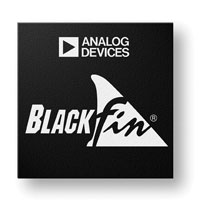NEWEST BLACKFIN® PROCESSORS EXPAND ANALOG DEVICES CONVERGENT-PROCESSOR PORTFOLIO, EXTEND LOW-POWER LEADERSHIP
Blackfin BF51x series maintains family’s focus on driving system-level reductions in cost, power consumption, complexity, and time-to-market
The new Blackfin processors are the BF512, BF514, BF516 and BF518. All are single-core convergent processors that surpass outdated, heterogenous MCU+DSP approaches in reducing part-count, system cost, board space, and power consumption. Like traditional DSPs, the BF51x processors feature high clock rates and low power dissipation per unit of processing (MMACs/mW), and like traditional MCUs, these convergent processors are OS and compiler-friendly.

All four of the new 16-/32-bit BF51x processors are available at clock speeds up to 400 MHz (800 MMACS) and include 116 kBytes of RAM plus an optional 4 Mbits of serial (SPI) flash memory. Each also integrates Lockbox™ security for code and content protection. Owing to the needs of low power, rich media applications where Blackfin processors are best suited, on-chip integration assures easy connection to a variety of audio, video, imaging and communications peripherals and memory types. Integrated features include support for sixteen stereo I2S digital-audio channels, twelve peripheral DMA channels, and an advanced memory controller for glueless connection to multiple banks of external SDRAM, SRAM, Flash, or ROM. Each processor includes two dual-channel synchronous serial communication ports (SPORTs), a high-speed parallel peripheral interface (PPI), an I2C compatible two-wire interface (TWI), dual PC-compatible UARTs, and 2 SPI-compatible serial peripheral interface ports.
“System solutions ultimately determine how much power any particular application will consume,” said Jerry McGuire, vice president, General Purpose DSP, Analog Devices, Inc. “It’s quite intuitive that a single convergent processor with the right mix of integrated peripherals is always going to lead to lower BOM costs and power consumption than an inelegant combination of disparate processors and parts can possibly achieve. Many companies today talk about the lowest power or the highest performance. But what is important for today’s applications is the highest levels of performance at low power.”
Low Power Leadership – Performance at Low Power
All of the new Blackfin processors, delivering 8.5 MMACs/mW (100 MHz), include dynamic power management (DPM) functionality that lets developers match the processor’s power consumption to processing requirements during program execution. ADI pioneered the application of DPM more than seven years ago with the release of the first Blackfin processors –devices that have consistently maximized power efficiency since debuting in October 2001.
To maximize energy efficiency, while providing the highest levels of performance at low power, Blackfin processors use a wide range of advanced design techniques including programmable voltage and frequency scaling, clock-cycle resolution dynamic clock gating, multiple power domains that support deep-sleep and hibernate modes, high code density to minimize bus-activation energy, mixed threshold-voltage transistor utilization for optimal performance and power efficiency, a full-custom processor core for maximum energy efficiency, judicious use of hardware accelerators, and support for mSDRAM to minimize board-level power consumption.
| C550x | 18 mW | 60 MHz | ||
| Blackfin BF516 | 16.5 mW | 60 MHz | ||
| C550x | 46 mW | 100 MHz | ||
| Blackfin BF516 | 24 mW | 100 MHz |
Ideal for Portable, VoIP Telephony and Industrial Instrumentation Applications
The BF512 is the new low-cost entry point in the Blackfin processor family. The device balances performance, peripheral integration, and price, and is well suited for the most cost-sensitive applications including portable test equipment, embedded modems, biometrics, and consumer audio. All members of the BF51x family also include a new 3-phase PWM generation unit for inductive motor control applications and a quadrature interface for rotary encoders.
The BF514, BF516, and BF518 all extend the convergent processor family further into the portable application space with on-chip removable-storage interfaces. All three devices include Secure Digital Input Output (SDIO) for connectivity to standard flash memory and Wi-Fi cards; a power-optimized CE-ATA storage interface for small form-factor handheld and consumer electronics applications; and an embedded multimedia card (eMMC) interface for integrating mass-storage flash memory in a wide range of consumer electronics, wireless, navigation, and industrial applications.
For developers of network-connected industrial and instrumentation applications, the BF516 adds an Ethernet 10/100 MAC with Media Independent Interface (MII) and Reduced Media Independent Interface (RMII). Highly integrated for industrial, portable and VoIP applications, the BF518 Ethernet MAC supports the IEEE-1588 clock synchronization protocol for networked measurement and control systems.
An increasingly wide variety of applications are viewing the contemporary convergent-processor approach as the soundest choice for cost- and power-sensitive designs. For example, some voice-over-IP (VoIP) telephony system developers have designed in separate DSP and microcontroller chips to implement the required media and control functionality. With BF51x Blackfin processors, however, a single architecture enables full VoIP telephony functionality in a unified software development environment with faster system debugging and deployment, lower overall system cost, and the lowest possible system power demand.
“GIPS VoiceEngine media processing capabilities meet the highest requirements of VoIP equipment manufacturers and paired with Analog Devices' Blackfin processors we can assure customers a consistently high quality VoIP experience. The performance, power and functionality profile of Blackfin is a superb fit for VoIP technology,” said Larry Golob, Senior Director Business Development, Global IP Solutions.
With the Global IP Solutions (GIPS) VoiceEngine package of VoIP software components available for Blackfin processors, and a VoIP reference platform available on uClinux, the feature-rich Blackfin family has driven down the price required to easily design and deploy a fully scalable range of VoIP telephony designs across multiple market spaces.
Pricing and Availability
The BF51x family includes the BF512 at $4.95, the BF514 at $7.75, the BF516 at $8.75 and the BF518 at $11.85. Processors are sampling immediately. All prices are based on 25,000-unit quantities.
To view an Arrow Electronics, Inc. co-sponsored webcast on the new Blackfin family, please visit http://w.on24.com/clients/adi/BF51x.
From: http://www.analog.com
Other news ...
- New Holtek HT82K68A-L 1.8V Low Voltage Wireless Keyboard/Mouse Mask MCU
- Fujitsu and Sun Unveil New Entry-level Server Powered by the SPARC64 Ⅶ Processor and the Solaris OS
- Webcast Highlights Fundamentals of Motor Evolution
- Tektronix SignalVu Analyzes RF Signals Up to 20 GHz Bandwidth
- Atmel Announces Royalty Free NORTi's OS for its AVR32 UC3 32-bit Flash MCUs
- Atmel and Adeneo Announce Windows Embedded CE 6.0 Training on AT91SAM ARM9 Embedded MPUs
- ANALOG DEVICES ENHANCES RF/IF SIGNAL CHAIN PERFORMANCE WITH HIGHLY INTEGRATED SYNTHESIZER AND MIXER FAMILY
- Atmel's picoPower 8/16-bit XMEGA MCU Cuts Power and Processing Requirement by 98%
- TI introduces the lowest power 1.8-V audio codec with integrated miniDSP in production today
- Industry's Lowest Power, Dual-Channel, 10-Bit ADCs Offer Superior Dynamic Performance
- National Instruments Expands High-Speed Digitizer Product Line
- National Semiconductor Introduces Industry’s First Differential Wideband Amplifier with Programmable Output Limiting Clamp
